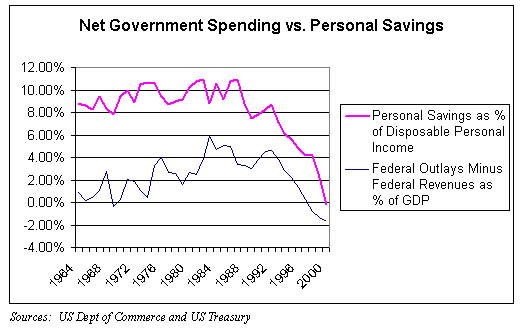Financial Engineers and The Brave New World
by Warren Mosler and Eileen Debold
�
�Just as the Corps of Engineers sustains the army�s fighting ability, our financial engineers have been sustaining the US post-Cold War economic expansion.� Financial engineering has effectively supported an expansion that could have long ago succumbed to the �financial gravity� economists call �fiscal drag.�� For even with lower US tax rates, the surge in economic growth has generated federal tax revenues in excess of federal spending.� This has led to both record high budget surpluses and the record low consumer savings that is, for all practical purposes, the other side of the same coin.� As the accounting identity states, a government surplus is necessarily equal to the non-government deficit.� The domestic consumer is the largest component of �non-government� trailed by domestic corporations, and non- resident (foreign) corporations, governments, and individuals.
�It is our financial engineers who have empowered American consumers with innovative forms of credit, enabling them to sustain spending far in excess of income even as their net nominal wealth (savings) declines.� Financial engineering has also empowered private-sector firms to increase their debt as they finance the increased investment and production.� And, with technology increasing productivity as unemployment has fallen, prices have remained acceptably stable.�Financial engineering begins deep inside the major commercial and investment banks with �credit scoring.�� This is typically a sophisticated analytical process whereby a loan application is thoroughly analyzed and assigned a number representing its credit quality.� The process has a high degree of precision, as evidenced by low delinquencies and defaults even as credit has expanded at a torrid pace.� Asset securitization, the realm of another highly specialized corps of financial engineers, then allows non-traditional investors to be part of the demand for this lending-based product.� Loans are pooled together, with the resulting cash flows sliced and diced to meet the specific needs of a multitude of different investors.� Additionally, the financial engineers structure securities with a careful eye to the credit criteria of the major credit rating services most investors have come to rely on.� The resulting structures range from lower yielding unleveraged AAA rated senior securities to high yielding, high risk, �leveraged leverage� mezzanine securities of pools of mezzanine securities.
�Private sector debt growth can only exceed income growth for a limited time, even if the debt growth is also driving asset prices higher.� At some point the supply of credit wanes.� But not for lack of available funds (since loans create deposits), but when even our elite cadre of financial engineers exhaust the supply of creditworthy borrowers who are willing to spend.� When that happens asset prices go sideways, consumer spending and retail sales soften, jobless claims trend higher, leading indicators turn south, and car sales and housing slump.� There is a scramble to sell assets and not spend income in a futile attempt to replace the nominal wealth being drained by the surplus.� Consequently, as unemployment bottoms and begins to increase, personal and corporate income decelerate, and government revenues soon fall short of expenditures as the economy slips into recession.� The financial engineers then shift their focus to the repackaging of defaulted receivables.
�Both Presidential candidates have voiced their support for maintaining the surplus to pay down the debt, overlooking the iron link between declining savings and budget surpluses.� For as long as the government continues to tax more than it spends, nominal $US savings (the combined holdings of residents and non-residents) will be drained, keeping us dependent on financial engineering to sustain spending and growth in the global economy.��
�Mr. Mosler is the chairman of A.V.M.� L.P. and director of economic analysis, III Advisors Ltd.� Ms. Debold is vice president, Global Risk Management Services, The Bank of New York.
�
9/5/2000
